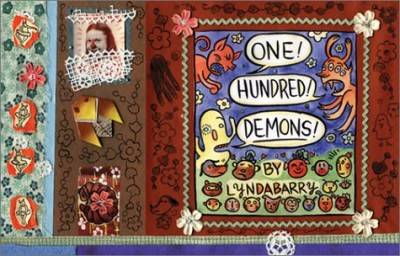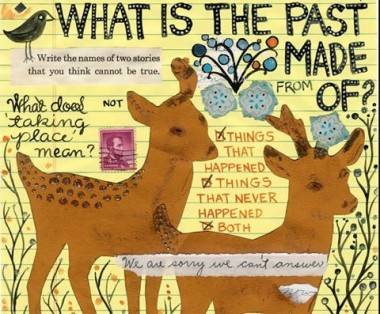Vancouver Writers Festival 2010–Lynda Barry
– by Shawn Conner
Lynda Barry is, I think, the Dalai Lama of cartoonists…
This past weekend I had the privilege of interviewing the artist. In Vancouver for the 23rd annual Vancouver International Writers (and Readers) Festival (Oct 19 – 24, 2010), she sat in on a couple of panels and, on Sunday morning, led a packed house through a series of writing exercises in a workshop that was a two-and-a-half-hour condensed version of a longer course she teaches in upstate New York.
Barry is probably best known for her long-running comic strip about her heroine Marlys, “Ernie Pook’s Comeek”, which has been appearing in alternative weeklies all over North America since 1979. The cartoonist is also the author of two illustrated novels, Cruddy (2000) and The Good Times Are Killing Me (2002), as well as the 2002 collection One! Hundred! Demons! and numerous collections of “Ernie Pook”.
Born in Wisconsin, Barry learned how to unleash her creativity at Evergreen State College in Oregon, then lived in Seattle before moving back to Wisconsin at the age of 30 (she is now 54). Her latest, Picture This, is a pictorial/drawing sequel to What It Is, her 2008 book in which she illustrates (and adds to) the lessons she learned at Evergreen from her teacher Marilyn Frasca about accessing the storyteller inside us all.
Playing with story and writing and memory, What It Is is really a must-read for anyone who is intimidated by the blank page. Both it and Picture This were published by Drawn & Quarterly, the Montreal company Barry credits for more or less saving her career when she couldn’t find a publisher.
As warm and wise in person (hence the Dalai Lama reference – you just feel good in her presence) as you would hope – uhm, our first topic notwithstanding – Barry was kind enough to sit down for this impromptu discussion the afternoon of Friday, Oct 22 at the Granville Island Hotel, Vancouver.
Lynda Barry: One of the things I like to ask people, especially after we’ve had a couple of drinks is, if you had to kill someone – if you had to, they were just really awful, what would be your style?
Shawn Conner: I haven’t given it much thought… I’m Canadian!
LB: I had lunch with four Canadians today, and they all came up with very detailed answers. I’ve been asking a lot of people and I’ve never heard the same answer twice. Today was four new ones! I’m an axe to the forehead kind of girl.
SC: Old Skull-Popper! [Old Skull-Popper is the name of the booze that figures prominently in Barry’s first novel, Cruddy.]
LB: There it is!
SC: Ever since I read Cruddy I wondered where that came from.
LB: Old Skull-Popper… [thinks] I don’t know for sure if I made it up or if I got it from somewhere, but I can tell you that I had a book on the Old West, and there were a lot of terms in there. I would say it was at least inspired by some of those terms, or maybe it was in there.
SC: You’re doing a workshop Sunday morning. I know you’ve been teaching, is it art or creativity?
LB: I teach writing. The funny thing is, the name of the class is, “Do You Wish You Could Write?” But somebody [at the Vancouver Writers Festival] named it, “Do You Think You Can Write?” So I was mortified when I saw it – it seems like the most aggressive kind of title!
It’s a writing class, a way of working when I was in college and studied with my teacher Marilyn Frasca. It gives step-by-step instructions. Her idea was that everything we call the arts, whether a painting or dance or writing, contains what she calls an image.
And she really believed that everything was a container for this thing, and once you understood what an image was and what it felt like, the form you gave it was up to you. But she convinced me when I was very young that they were all the same thing. The quickest way to show people how to do it is with writing.
SC: It’s “the old skull-popper.”
[There follows a discussion about the biological benefits of art.] Should governments fund the arts? There’s been a huge hue and cry here in B.C. with cuts to funding, but in the U.S. I think arts funding is almost non-existent. And then I think of this short story by Lorrie Moore, there’s a character in there, a father whose son has cystic fibrosis, and he’s talking to a dancer friend of his and he says, “I love the arts, blah blah. But I think every fucking extra penny should be put into medical research.” I’m paraphrasing. Isn’t art, whether enjoying or making it, a privilege?
LB: Let’s talk about what art is… I think governments should be funding it just like they should be funding health care and public school. There’s the art that’s up in galleries and you don’t know what the hell it is, sometimes I look at it and have to imagine it in a gas station because I can’t tell how I feel about it when it’s in a gallery.
But there have been some really interesting studies done on the brain, and there was this really interesting study on what’s going on in an adult’s brain when they’re engaged in what’s called “creative concentration”. And then, a kid’s brain, when they’re engaged in “deep play”, where you’re playing with an object but it seems like the object is playing back with you, what they found is, they’re nearly identical – the entire brain is activated.
So I started to think about kids, and play. If you have a kid, and you give them everything they need but they’re never allowed to play until they’re 21, most people understand that person would have a lot of trouble. There’d be some mental health issues. Why do we know that? There’s a tacit understanding – because we’ve experienced it.
So this kid’s never allowed to play – let’s show him a picture, or a DVD, or go live. It’s not going to work. And I think that’s where people are as adults – this idea that, unless we’re really good at something by a certain age, you have no right to continue to do it.
And I think this stuff has a biological function, and it’s corollary is to our immune system. And I think it has to do with being able to cross from one side of the brain to the other, though I think it’s a lot more complicated than that.
The arts are key – look at a high school student and his relationship to music. Or to skateboarding. Which I would argue is art. I would even argue it’s drawing. So yeah, I think government should fund it. But I also think they should do a lot of other stuff. If I ran the circus…
But Canada has always been a little beacon of hope for us, that there has been an acknowledgment that this has an important function. And it’s another reason a town like this seems so rich.
So I don’t think it’s a privilege, and I also don’t think you can stop people from doing it.
[The conversation turns to the act of reading, and drawing, and doodling in the margins and how that helps time go faster; I admit one of my favourite things to doodle is Tony Millionaire‘s Drinky Crow…]
LB: Drinky Crow is awesome! I was just spending time with Tony Millionaire. Did you know he’s 6′ 5″? And he’s very charming and a gent, a total gent. We were staying at the same hotel in San Francisco and we were at [Eightball and Ghost World cartoonist] Dan Clowes‘ house and afterwards we got into town, and Tony had had quite a few to drink and I’d had a few less, and he just took my hand and I was kind of walking this giant man down the street.
SC: Do you feel close to other cartoonists? Are you part of that community?
LB: I do feel very close to cartoonists, come to think of it. I mean, I’ve been doing this for thirtysomething years, so it’s hard to remember what I used to feel like before. I actually feel close to anybody who’s just making something.
SC: You’re a pioneer when it comes to comics, being one of the first in the new wave of alternative comics back in the early 1980s.
LB: I suppose. I think there were a lot of people at the same time. [Black Hole cartoonist] Charles Burns, I went to high school with him. I always feel [Evergreen State College classmate] Matt Groening, because The Simpsons is so huge, his comic work [Life In Hell] is totally disregarded. It’s like it’s not even mentioned. But he was doing stuff early on.
And then, Stan Mack, who did “Real Life Funnies”, in the Village Voice. Jules Feiffer, M.K. Fisher, there were all these people who kind of fell in the gap, who were big influences on me. I feel the one thing I did, I was able to do sad comics. That might have been unusual.




